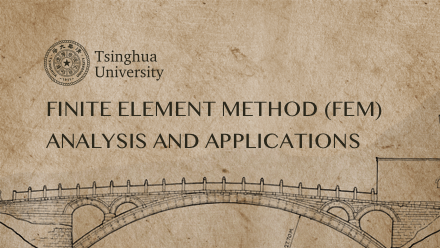
当前课程知识点:Finite Element Method (FEM) Analysis and Applications > 2、Finite element method of bar system based on direct stiffness method > 2.2 Comparison between spring element and bar element > Video 2.2
返回《Finite Element Method (FEM) Analysis and Applications》慕课在线视频课程列表
返回《Finite Element Method (FEM) Analysis and Applications》慕课在线视频列表
下面我们基于弹簧单元的描述
再分析一下杆单元的描述
弹簧单元我们都知道
它的基本的力学行为是F=k·δ
同样我们假定有一个一维的拉杆
我们做一个单拉实验
同样我们也可以得到相应的物理方程
也叫虎克定律
也就是说应力等于弹性模量乘上应变
由于这是一个一维的拉杆问题
所以应力就是外力,也就是说右端的外力
除上相应的横截面面积
应变是伸长量除以原长也就是δ/l
把这两个关系代入到一维的拉杆的虎克定律里
我们就得到这么一个关系
给它作一个变换以后
就得到一个右端点的力
和右端点的伸长量之间的一个关系
再和弹簧进行一个对照
就发现弹簧的刚性系数
和拉杆的弹性模量乘上横截面面积再除以l
这存在一个转换关系
也就是说弹簧和杆单元通过刚性系数的转换
就可以用弹簧的平衡方程得到杆单元的平衡关系
同样,弹簧单元我们用两个节点来描述
1号节点,2号节点
也有相应的节点力和节点位移
那么对于杆单元
同样,我们也给出1号节点和2号节点
当然还有这个杆单元的弹性模量
横截面面积和长度
同样,1号节点的节点位移、节点力
2号节点的节点位移和节点力
那么弹簧单元的平衡关系前面我们已经构造了
通过刚才的一个对照
我们只要把弹簧的刚性系数作一个置换
就可以得到杆单元的平衡关系
它也是左节点、右节点之间的一个平衡关系
我们把这个方程用矩阵写出来
其中这个qe就是节点位移
注意它是一个列阵
Fe它也是一个列阵
那么这个单元的刚度阵,我们叫Ke
它也是刚度矩阵
那么我们后面要用的就是这么一个平衡关系
也叫刚度方程
那还是以刚才和弹簧对应的例题
我们考虑两个杆两端固定的这么一个结构
和刚才的两个弹簧对应
中间的节点作用一个力
左端点和右端点是固定的
按照和刚才对应的关系
我们把这个杆单元的1号单元、2号单元
分离出来,分别来进行描述
同样也有节点的位移描述
还有节点的力的描述
和弹簧情况类似
只要我们把刚才两弹簧结构的结果作一个替换
也就是说把相应的刚性系数替换一下
同样我们也可以得到相应的结果
也就是说2号节点位移是这样的
两个支反力得到的结果是这样的
它和弹簧的结果有一个对应的关系
-Finite element, infinite capabilities
--Video
-1.1 Classification of mechanics:particle、rigid body、deformed body mechanics
--1.1 Test
-1.2 Main points for deformed body mechanics
--1.2 Test
-1.3 Methods to solve differential equation solving method
--1.3 Test
-1.4 Function approximation
--1.4 Test
-1.5 Function approximation defined on complex domains
--1.5 Test
-1.6 The core of finite element: subdomain function approximation for complex domains
--1.6 Test
-1.7 History and software of FEM development
--1.7 Test
-Discussion
-Homework
-2.1 Principles of mechanic analysis of springs
--2.1 Test
-2.2 Comparison between spring element and bar element
--2.2 Test
-2.3 Coordinate transformation of bar element
--2.3 Test
-2.4 An example of a four-bar structure
--2.4 Test
-2.5 ANSYS case analysis of four-bar structure
--ANSYS
-Discussion
-3.1 Mechanical description and basic assumptions for deformed body
--3.1 Test
-3.2 Index notation
--3.2 Test
-3.3 Thoughts on three major variables and three major equations
--3.3 Test
-3.4 Test
-3.4 Construction of equilibrium Equation of Plane Problem
-3.5 Test
-3.5 Construction of strain-displacement relations for plane problems
-3.6 Test
-3.6 Construction of constitutive relations for plane problems
-3.7 Test
-3.7 Two kinds of boundary conditions
- Discussion
-- Discussion
-4.1 Test
-4.1 Discussion of several special cases
-4.2 Test
-4.2 A complete solution of a simple bar under uniaxial tension based on elastic mechanics
-4.3 Test
-4.3 The description and solution of plane beam under pure bending
-4.4 Test
-4.4 Complete description of 3D elastic problem
-4.5 Test
-4.5 Description and understanding of tensor
-Discussion
-5.1 Test
-5.1Main method classification and trial function method for solving deformed body mechanics equation
-5.2 Test
-5.2 Trial function method for solving pure bending beam: residual value method
-5.3 Test
-5.3How to reduce the order of the derivative of trial function
-5.4 Test
-5.4 The principle of virtual work for solving plane bending beam
-5.5 Test
-5.5 The variational basis of the principle of minimum potential energy for solving the plane bending
-5.6 Test
-5.6 The general energy principle of elastic problem
-Discussion
-6.1Test
-6.1 Classic method and finite element method based on trial function
-6.2 Test
-6.2 Natural discretization and approximated discretization in finite element method
-6.3 Test
-6.3 Basic steps in the finite element method
-6.4 Test
-6.4 Comparison of classic method and finite element method
-Discussion
-7.1 Test
-7.1 Construction and MATLAB programming of bar element in local coordinate system
-7.2 Test
-7.2 Construction and MATLAB programming of plane pure bending beam element in local coordinate syste
-7.3 Construction of three-dimensional beam element in local coordinate system
-7.4 Test
-7.4 Beam element coordinate transformation
-7.5 Test
-7.5 Treatment of distributed force
-7.6 Case Analysis and MATLAB programming of portal frame structure
-7.7 ANSYS case analysis of portal frame structure
-8.1 Test
-8.1 Two-dimensional 3-node triangular element and MATLAB programming
-8.2 Test
-8.2 Two-dimensional 4-node rectangular element and MATLAB programming
-8.3 Test
-8.3 Axisymmetric element
-8.4 Test
-8.4 Treatment of distributed force
-8.5 MATLAB programming of 2D plane rectangular thin plate
-8.6 Finite element GUI operation and command flow of a plane rectangular thin plate on ANSYS softwar
-Discussion
-9.1 Three-dimensional 4-node tetrahedral element and MATLAB programming
-9.2 Three-dimensional 8-node hexahedral element and MATLAB programming
-9.3 Principle of the isoparametric element
-9.4Test
-9.4Numerical integration
-9.5 MATLAB programming for typical 2D problems
-9.6 ANSYS analysis case of typical 3Dl problem
-Discussion
-10.1Test
-10.1Node number and storage bandwidth
-10.2Test
-10.2 Properties of shape function matrix and stiffness matrix
-10.3Test
-10.3 Treatment of boundary conditions and calculation of reaction forces
-10.4Test
-10.4 Requirements for construction and convergence of displacement function
-10.5Test
-10.5C0 element and C1 element
-10.6 Test
-10.6 Patch test of element
-10.7 Test
-10.7 Accuracy and property of numerical solutions of finite element analysis
-10.8Test
-10.8 Error and average processing of element stress calculation result
-10.9 Test
-10.9 Error control and the accuracy improving method of h method and p method
-Discussion
-11.1 Test
-11.1 1D high-order element
-11.2 Test
-11.2 2D high-order element
-11.3 Test
-11.3 3D high-order element
-11.4 Test
-11.4 Bending plate element based on thin plate theory
-11.5 Test
-11.5 Sub-structure and super-element
-12.1Test
-12.1 Finite element analysis for structural vibration: basic principle
-12.2 Test
-12.2 Case of finite element analysis for structural vibration
-12.3 Test
-12.3 Finite element analysis for elastic-plastic problems: basic principle
-12.4 Test
-12.4 Finite element analysis for elastic-plastic problems: solving non-linear equations
-Discussion
-13.1 Test
-13.1 Finite element analysis for heat transfer: basic principle
-13.2 Test
-13.2 Case of finite element analysis for heat transfer
-13.3 Test
-13.3 Finite element analysis for thermal stress problems: basic principle
-13.4 Test
-13.4 Finite element analysis for thermal stress problems: solving non-linear equation
-Discussion
-2D problem: finite element analysis of a 2D perforated plate
-3D problem: meshing control of a flower-shaped chuck
-Modal analysis of vibration: Modal analysis of a cable-stayed bridge
-Elastic-plastic analysis: elastic-plastic analysis of a thick-walled cylinder under internal pressur
-Heat transfer analysis: transient problem of temperature field during steel cylinder cooling process
-Thermal stress analysis: temperature and assembly stress analysis of truss structure
-Probability of structure: Probabilistic design analysis of large hydraulic press frame
-Modeling and application of methods: Modeling and analysis of p-type elements for plane problem
